


Yarrow
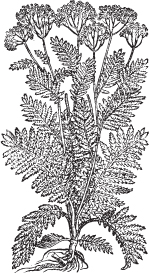
Long used to staunch wounds (on battlefields and elsewhere), yarrow’s pinky white flowers and feathery leaves grace many a field and grassland area in temperate zones across the world.
USES Yarrow is used to treat period pains, high blood pressure, blood vessel problems, fevers, and respiratory allergies; it can also improve digestion. Although yarrow stops hemorrhaging, taken both internally and used externally, the leaves and flowers are anticlotting for the circulatory system. Take as tea, tincture, lotion, salve, or poultice.
Its root secretions are known to be strengthening to other plants, making them more resistant to disease, and the plant repels harmful insects in the yard.
Some people are allergic to yarrow. Do not use in pregnancy.
AESCULUS HIPPOCASTANUM
Horse Chestnut
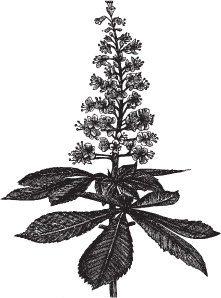
This majestic tree, a native of southeastern Europe, is now cultivated throughout the world. It produces fragrant candles of small flowers and a profusion of brown, shiny, nutlike seeds, protected by spiky green cases.
USES The seeds, or “conkers,” are used in internal and external medicines to strengthen blood vessels, especially the veins. In large doses, horse chestnuts are poisonous—do not mistake it for sweet chestnut and eat too many.
The safe medicinal dose is about 1–2g three times daily. Take as a tincture or in powder form, or apply as a lotion or cream.
AGRIMONIA SSP.
Agrimony
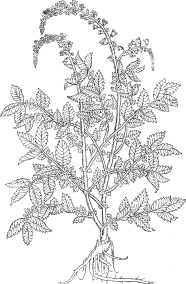
A 3-foot tall perennial herb with carrotlike leaves, agrimony is green on top and silvery underneath, with thin spikes of small yellow flowers. It prefers a wet habitat.
USES Agrimony’s main quality is its astringency, which means it is drying and toning to mucous membranes. This makes it useful to tone the digestive system, and as a mouthwash for gum disease. It is used to treat bladder and kidney weakness.
Agrimony is also a flower remedy for tension and pressure, especially for those who put on a brave face. Externally, it is an excellent healer of wounds, including varicose ulcers. Take as a tea, tincture, or external preparation.
ALCHEMILLA VULGARIS
Lady’s Mantle
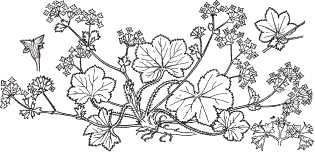
This delicate, yellow-green plant has soft, capelike leaves that collect dew and tiny, green-yellow flowers. It is usually found in damp meadows, woods, and grassy mountains.
USES An excellent general tonic for the womb, lady’s mantle stops excess bleeding—menstrual or menopausal—and regulates the female hormonal cycle. The herb also helps women to recover from emotional and physical trauma related to the womb. Being astringent, it can ease diarrhea and mucous problems of the digestive tract. Its astringency, coupled with an ability to stem bleeding, makes lady’s mantle a good healer of wounds. Take as a tea or a tincture, or in a healing salve or poultice. It is not generally used in pregnancy.
Garlic

The bulb of this typical, easy to grow member of the onion family is used in cooking all over the world. Its cousin, Allium ursinum (wild garlic, bear garlic, or ramsons)—available online to grow from seeds—grows all over Europe and can be used similarly.
USES Garlic is highly effective in fighting infections of all kinds, including coughs and colds, sinusitis, and intestinal parasites. Used in treating hay fever and other allergies, it can also lower blood cholesterol and high blood pressure.
Some research has found it to be a possible neurotoxin that adversely affects the brain, so it may be best regarded as a medicine for occasional use. Garlic can be eaten raw or made into a powerful tincture, or applied externally to infections.
ALOE VERA
Aloe

This cactuslike plant has long, pointed, succulent leaves edged with small white teeth. It is good to grow as a houseplant, so you can split the dark green leaves, reach the clear gel within, and use it fresh.
USES Aloe juice is rich in vitamins, minerals, and health-giving enzymes. It is powerfully detoxifying and an excellent cleanser. Anti-inflammatory for the stomach and colon, aloe juice is used to treat irritable bowel syndrome (IBS) and other digestive inflammations. It helps to heal burns and ulcers and is used in many skin products.
Do not take in pregnancy or when breastfeeding, or if the kidneys are weak. Do not take internally long-term without regular breaks.
ALTHAEA OFFICINALIS
Marshmallow

Originally from Africa and now widely cultivated, marshmallow is a tall perennial herb. It has pale pink flowers and soft, furry, light green leaves.
USES The leaves and root are used to soften and soothe inflammations of the lungs, digestive tract, urinary tract, and skin. The root tends to be used more for digestion and lungs, the leaves for the kidneys.
The root can be chewed by teething babies. In ancient Egypt, marshmallow was mixed with oats and honey to make a sacred confectionery offered to the gods.
ANGELICA ARCHANGELICA
Angelica

A tall and powerful aromatic bitter of the Umbelliferae family, angelica has tiny flowers with distinctive, umbrella-shape flower heads. Angelica is found most often growing alongside rivers, preferring damp and shady places. Originally native to Syria, it is now widely cultivated.
Be careful when collecting this herb because angelica can easily be mistaken for hemlock, which is poisonous.
USES Stems and roots can be eaten. In medicinal terms, angelica is an aromatic bitter that removes damp and cold from the body. It stimulates the liver and digestive tracts, and is a valuable tonic for the whole system. The root is especially useful for the lungs. All parts of the plant are used, in teas, tinctures, and foods. Do not take medicinally during pregnancy.
Burdock
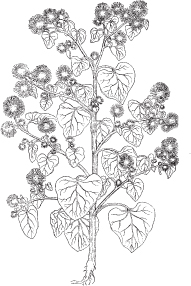
In burdock’s first year, only the leaves appear. They are low to the ground, large, and flannelly, with a distinctive smell and feel, being woolly on the underside. In its second year, the plant grows a tall, robust stem with leaves and small pinky purple, thistlelike flowers, which form seed burrs. Native to Europe, it is naturalized in the United States.
USES Burdock is a blood-cleansing herb that is antibiotic, antifungal, and adaptagenic (protects the body from stress). It lowers blood sugar, stimulates the kidneys, promotes sweating, and is used to treat many skin diseases, as well as arthritis and any condition where detoxifying is necessary. The root, leaves, and seeds are used in teas, tinctures, and foods.
ARMORACIA RUSTICANA
Horseradish
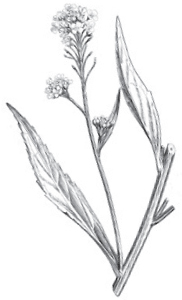
Horseradish is a member of the cabbage family native to Europe and western Asia, then introduced to North America. It has strong, large green leaves and small white flowers.
USES Though best known as a culinary herb, horseradish root is a useful antibiotic and immune-stimulating medicine. It is especially good for infections of the sinuses, lungs, kidneys, and digestive tract, and removal of mucus from the body. It is also a strong diuretic that breaks up kidney stones and a stimulant for the circulation.
Horseradish is easy to grow and best used fresh. It is taken internally as a tincture, tea, and food, and used externally in lotions.
ARTEMISIA ABSINTHIUM
Wormwood
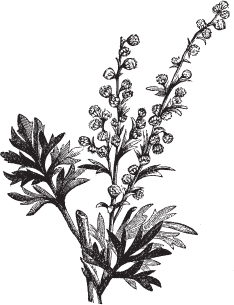
This bitter herb with small yellow flowers is native to Europe, but now also grown in Asia and the United States. It can easily be grown from seed or by dividing the roots in fall.
USES Wormwood is used to treat parasite infections of the digestive tract and as a general tonic. It is a bitter liver stimulant that affects the central nervous system, and is best used in small amounts. Wormwood was a key ingredient in the liquor “absinthe,” which has mind-altering effects.
Its cousin, A. annua, or Chinese wormwood, has been found to be effective against malaria. In countries where the disease is prevalent, there have been programs to encourage growing of Chinese wormwood for use in treatments.
Do not take during pregnancy.
ARTEMISIA VULGARIS
Mugwort
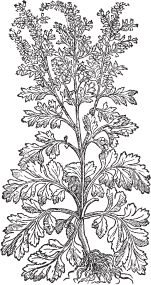
Also known as Chrysanthamum weed, mugwort grows over most of Europe and North America. The under leaves are white, the flowers white-green and small, but they grow in profuse spikes.
USES Mugwort leaves and flower buds can be used to flavor soups or eaten for their minerals (and their ability to help the body absorb minerals). It is a bitter liver tonic of particular help to the womb, nervous system, and stomach.
Mugwort can be taken as a tea or tincture, and can be smoked, like a cigarette, or burned as an incense. It is also used in acupuncture in a procedure called “moxibustion,” where it is burned into the patient’s skin. Mugwort is said to help to develop lucid (conscious) dreaming.
Do not take during pregnancy.
Huang Qi or Milk Vetch
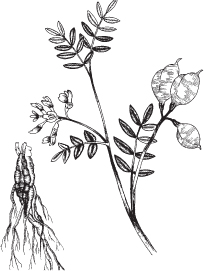
The root of this yellow-flowered member of the vetch family has been used for thousands of years in Chinese medicine for its invigorating qualities. It is native to temperate regions of the Northern Hemisphere.
USES A tonic for the immune system, milk vetch increases our ability to fight off viral disease. It supports the immune system, so helps with chronic fatigue, and also supports people having chemotherapy and radiation therapy. Milk vetch is a general tonic for the digestion, heart, and liver, and may also be used to help prolapsed organs, especially the womb. The root is decocted into a tea or made into a tincture.
AVENA SATIVA
Oat Straw

Oats are a tall grass with straight stems and small seed heads. Herbalists use “oat straw”—the green grass and tops of oats before the mature oats are formed—as a powerful medicine. It is native to temperate parts of Europe and Asia, and is widely cultivated around the world.
USES Superrich in minerals and vitamins, oats are a nutritious, health-enhancing, cholesterol-lowering food.
A tonic and nourishing herb for the nerves, including the brain, oat straw is used for fatigue, depression, and anxiety, and to improve concentration. It can help with insomnia caused by overexhaustion and may also be used as an aphrodisiac and reproductive tonic. It is taken as a tea or tincture; the grass may be eaten in green smoothies.
BAPTISIA TINCTORIA
Horseflyweed/Wild Indigo

A yellow-flowered perennial in the vetch family, horseflyweed is native to North America. Widely used in herbal medicine, where it is also known as wild indigo, which refers to its traditional use as a blue dye.
USES Wild indigo root is used in herbal medicine as an antiseptic blood cleanser and to stimulate immunity against infection. It is especially suited for digestive infections, including typhus, gastric flu, mouth infections, and sepsis anywhere in the body.
BERBERIS VULGARIS

Barberry is a thorny deciduous shrub from Africa, Asia, and southern Europe, now naturalized in the United States. It has small, leathery leaves, yellow bark, and flowers and red berries.
USES In many countries, barberry’s tart red berries are eaten in savory dishes and preserves. The yellow bark of its stem and root are used as a dye and a powerful medicine.
Barberry contains berberine, an antibacterial, antiprotozoal, and antiparasite antibiotic that is also anti-inflammatory. Used for intestinal infections and eye infections, parasites, and malaria, barberry is a bitter stimulant for the liver.
Do not take during pregnancy or long-term (more than 2 months).
Oregon Grape
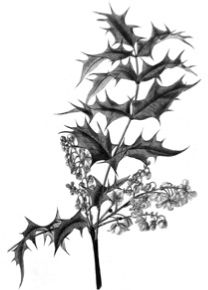
Also known as hollyleaved barberry, Oregon grape is an evergreen from North America in the Berberidaceae family, now grown in Europe. Growing to 6 feet, it has prickly, hollylike leaves, clusters of yellow flowers, and small black berries.
USES A bitter tonic for the liver and digestive system, Oregon grape also contains berberine (so can be used in a similar way to barberry, here). It is much used to treat psoriasis, eczema, and other skin diseases, being a detoxifier and tonic.
The inner bark produces a yellow dye, the berries a purple one. Berries can also be eaten, usually cooked and mixed with a sweeter fruit. The root is used in medicines.
Do not take during pregnancy.
BORAGO OFFICINALIS
Borage
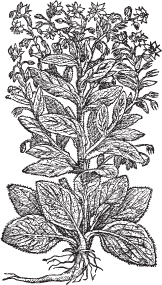
Native to the Mediterranean and widely grown elsewhere, borage is a bristly haired, bright green herb with characteristic blue, star-shape flowers. Star-flower oil is extracted from its seeds. Star-flower oil contains high levels of GLA (gamma linoleic acid), which has many beneficial health effects, including helping to regulate hormone levels, so it can help reduce PMS.
USES Borage is cooling and moistening, and is used in herbal medicine as an adrenal tonic for stress, exhaustion, and depression. It soothes stomach inflammations and reduces catarrh in the body.
Borage leaves and flowers can be eaten and are delicious. The leaves contain low levels of pyrrolixidine alkaloids, so there are some concerns about borage’s safety, because in high doses these damage the liver. Take borage for only a few weeks at a time, and do not take if you have any liver disease or weakness. If in doubt, consult a medical herbalist.
CALENDULA OFFICINALIS
Pot Marigold

Originally from southern Europe, pot marigold grows in any temperate climate and is now found all over the world. It is easy to grow and ideal for novice gardeners. The vibrant orange flowers have medicinal use.
USES Pot marigold is one of the most versatile and amazing plants. The anti-inflammatory flowers heal wounds and work against bacteria, viruses, and fungal infections. They are used in preparations for skin problems of all kinds.
Pot marigold flowers are also effective as a healing remedy for the digestive tract, and for strengthening the liver as well as the nervous system.
CAPSICUM SPP.
Cayenne Pepper

Cayenne is a hot chile pepper with long green “fruits,” which usually turn red on ripening. It is native to both South and Central America.
USES Cayenne pepper fruits are taken as a powerful circulatory stimulant, dilating blood vessels and speeding up flow around the body. The plant speeds up metabolism, helps to burn fat, and suppresses the appetite: it is also said to be an aphrodisiac.
Cayenne pepper is consumed as a powder or tincture, or taken externally as a warming pain-killer. It is also used as a spray to deter insects on other plants. Do not use on broken skin or delicate areas, and keep away from the eyes.
Do not take medicinal doses in pregnancy.
Greater Celandine
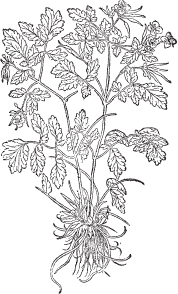
A member of the poppy family with small yellow flowers, the stem of greater celandines produces an orange latex. (Latex is a milky exudate that some plants contain, including opium in poppies and rubber from rubber plants.) Native to Europe, it is widely grown in the United States.
USES A bitter tonic for all manner of liver and gall-bladder diseases, greater celandine is also a mild sedative for the internal organs. It is used to treat whooping cough, asthma and bronchitis with spasm, and for pain in the digestive system. The herb is taken and applied for eczema, and for eye disease and cancers. It is used as a tea, tincture and lotion, and the latex can be directly applied to warts.
Do not take during pregnancy.
CIMICIFUGA RACEMOSA
Black Cohosh
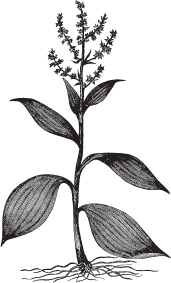
A graceful woodland perennial native to the United States and now naturalized in Europe, black cohosh has long, bending spikes of white flowers (3 feet in length). Now reclassified as Actaea racemosa and sometimes called black baneberry, black cohosh root was traditionally used for medicine by many Native American tribes.
USES An anti-inflammatory, black cohosh is helpful for sciatica, back pain, cramp, arthritis, and is sometimes used for migraines. It is a relaxing nerve tonic that can quietena cough.
Black cohosh can also be helpful for period pains, and for painful breasts and headaches caused by hormonal imbalance, as well as menopausal hot sweats.
Do not use in pregnancy or when breastfeeding. Do not take for more than 6 months without a break.
CRATAEGUS MONOGYNA
Hawthorn
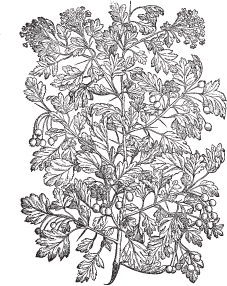
This wonderful common hedge plant and field tree with its rugged bark, profusion of white-pink flowers, and red berries is found throughout Europe. Several North American cousins have similar medicinal properties, including Crataegus chrysocarpa (fireberry hawthorn) and C. douglasii (black hawthorn) as well as C. pinnatifida (Chinese hawthorn).
USES In German herbal medicine, hawthorn is known as “the mother of the heart,” and its flowering tops and berries are used to treat all manner of heart disease: angina, abnormal heart rhythms, heart failure, high blood pressure, and diseases of the arteries.
CURCUMA LONGA
Turmeric
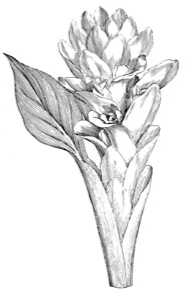
This tropical plant is native to South India, and is widely grown in hot and wet areas of the tropics. Its large green leaves grow to around 3 feet and its flowers are whitish green. The yellow rhizomes (roots) are used in cooking. Turmeric is considered to be an exceptionally powerful medicinal plant.
USES A supreme anti-inflammatory, liver activator, and antioxidant blood cleanser, turmeric is useful in any inflammatory condition. These include arthritis, skin disorders, asthma, cancers, and heart disease. The herb has been shown to be of help in dementia and diabetes. It is normally used in dried powder form because it is imported from India, but if you can get turmeric fresh, try eating it grated, or as a juice—it is amazing. It also makes a bold yellow dye.
Wild Yam
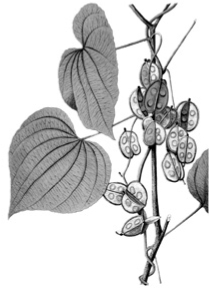
Native to North and Central America, wild yam will grow in subtropical and temperate zone woodlands. It consists of a vine growing from tubers (potato-like roots), which are the part used in medicine.
USES Wild jam is traditionally used as an anti-spasmodic, especially for digestive tract spasm or colic, and also as an anti-inflammatory for inflamed bowels and arthritic conditions. It is also used to treat women’s hormonal imbalances; common in menopausal mixes, the plant is famous for containing diosgenin, from which the first contraceptive pill was developed. It is taken as a tea, tincture, and cream.
ECHINACEA SPP. (E. PURPUREA AND E. ANGUSTIFOLIA)
Purple Coneflower
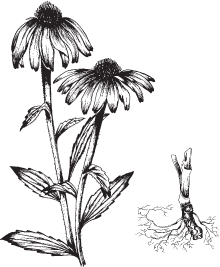
Native to the United States but now cultivated and known far and wide, this perennial boasts a lovely, large, daisy-type purple flower. The whole plant (root and flowering tops) is used for medicine.
USES Echinacea is an immune stimulant, helping the body to fight infections and cleaning the blood. It is antimicrobial and can be used to treat boils, ulcers, eczema, and any infection anywhere in the body. Good-quality echinacea makes the tongue tingle when you taste it or chew it. It is taken as a tincture, tea, and pills.
ELEUTHEROCOCCUS SENTICOSUS
Siberian Ginseng

Native to Russia, China, Korea, and Japan, Siberian ginseng is a woody shrub, 10 feet in height, with blackish berries and large, dark green leaves with 3–7 lobes.
USES The root is used as a strong adaptogen (meaning that it helps protect the body from the damaging effects of stress) and stimulant. It is often used to boost long-term immunity, including for people with immunosuppression following radiation therapy or chemotherapy. Siberian ginseng is helpful in any stress-related condition, including those caused by hormonal problems, such as postnatal depression and menopausal difficulties.
It is best used for short periods of time. For some people, it is too stimulating, causing anxiety and panic, especially in high doses. Siberian ginseng is mostly used as a tea and tincture.
EQUISETUM SPP. (E. ARVENSE AND E. HYEMALE)
Horsetail

This ancient plant with thin, rigid, dry branching stems and leaves resembles a horse’s tail. It likes wet, marshy places and grows up to 2 feet in height.
USES Horsetail is rich in silica in a readily absorbable form. A lack of silica can be recognized by weakness of the hair and nails, multiple allergies, chronic bladder inflammation, and muscle and joint problems.
Horsetail helps to stop bleeding, especially of the bladder and reproductive organs, and is also used for urinary incontinence.
Be careful not to confuse it with E. palustre (marsh horsetail), which is much larger and is toxic.
Meadowsweet
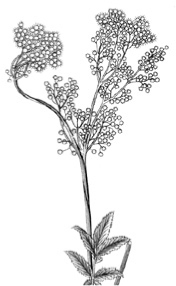
Also known as Queen of the Meadow, this lovely herbaceous perennial, with its shower of creamy-white flowers and distinctive smell, is native to Europe and Asia and naturalized in the United States.
USES Meadowsweet is a useful anti-inflammatory for the stomach and intestines, and for the joints. It relieves and heals stomach ulcers and heartburn and calms an overactive digestion, so can help to stop diarrhea. The herb also contains salicylic acid (aspirin), so lowers fevers and thins blood.
GALIUM APARINE
Cleavers, Goosegrass
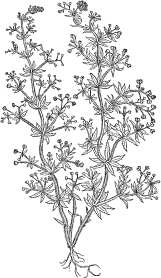
This creeping plant grows all over Europe, North America, and parts of Asia. Cleavers stays close to the ground and climbs over other plants. Its hairy stems are square, its flowers tiny and white, and its fruits resemble little balls.
USES Cleavers is used to encourage the lymphatic system to detoxify the body. It is taken for any condition in which toxic buildup could be an issue, including conditions of the skin and joints and certain cancers.
GENTIANA LUTEA
Gentian

Gentian grows in the Alps and other mountainous regions. It has oval leaves and star-shape yellow flowers, and grows to around 4 feet in height. Its bitter roots are collected in fall from plants that are more than 8 years old, which is when they first begin to flower.
USES Gentian stimulates the liver and digestion, regulates blood sugar, and is a general tonic. It is used usually in small quantities, with a tincture of the root normally being taken at 2–10 drops per dose. Taken directly on the tongue, gentian can help reduce sugar cravings. Avoid if you experience acid indigestion or a stomach ulcer.
GINKGO BILOBA
Ginkgo

This magnificent and ancient tree, with green, fan-shape leaves, has been around for about 190 million years. Growing to 100 feet, it is native to China and Japan, but is now grown all over the world.
USES The leaves are famous as a brain medicine, stimulating the flow of blood to the brain. Ginkgo is used to treat memory loss and problems of the central nervous system, including dementia, stroke, and multiple sclerosis. It has an anticlotting effect in the blood.
Ginkgo can also help with asthma, being strongly anti-allergic and anti-inflammatory. It is usually taken in tincture or pill form, or as powder.
Licorice
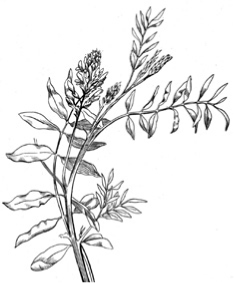
A woody stemmed member of the pea family, with creamy-white flowers, licorice is native to southern Europe and Asia. It is now widely cultivated.
USES Licorice is famous as a confectionery, full of delicious natural sugars. It is such a useful medicine that it has been called “the universal herb.”
An adrenal tonic for exhaustion and fatigue, it is anti-inflammatory for the stomach and digestive tract and soothes the lungs and urinary system. Licorice also heals externally and can help ulcers and eczema (it makes an especially black ointment).
Do not use during pregnancy, or with liver damage or high blood pressure.
HYPERICUM PERFORATUM
St. John’s Wort

This beautiful wayside weed with small yellow flowers is indigenous to Europe, but introduced in temporate zones of the Americas. If you hold the leaves up to the light, you will find little see-through dots; these are oil glands.
USES In addition to its now famous use as an antidepressant, St. John’s wort is taken as a tea, capsules, or tincture for stress and anxiety, and to treat damage to and diseases of the nerves (including shingles and multiple sclerosis). It supports the immune system and stimulates the liver. The lovely infused oil is anti-inflammatory, antiviral, and wound-healing.
It can cause sensitivity to sunlight and interacts with some medicines, including the oral contraceptive pill. Seek medical advice if you are taking any medication.
INULA HELENIUM
Elecampane

This robust member of the daisy family is native to Europe, but naturalized in the United States. It grows in many places, preferring shady woods and damp pastures. It grows 3–5 feet tall, with yellow flowers and pointed leaves. The root, dug in fall from plants over 2–3 years old, is used for medicine.
USES Elecampane root is a warming tonic, especially good for the lungs; it treats coughs, catarrh, and serious lung disorders of all kinds. Elecampane root is also useful to improve digestion and to treat hemorrhoids, debility, and exhaustion.
Do not take during pregnancy or if breastfeeding.
IRIS VERSICOLOR
Blue Flag
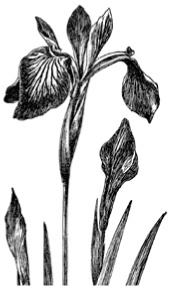
This beautiful wetland iris, a native of North America, has characteristic purple yellow and whitish flowers much loved by florists. The root is used in herbal medicine throughout the USA and Europe.
USES Used in small doses, the root has the action of stimulating a sluggish liver; it also improves eczema and other skin diseases, encourages the lymphatic system, and moves the bowels. Blue flag root is useful for acne, psoriasis, and shingles, and can also help people with an underactive thyroid.
Do not take in pregnancy. It can also cause vomiting in large doses.
Black Walnut

This beautiful tree is native to the United States but has been widely introduced in Europe. It produces a fruit that falls with its husk, green, in fall, and this green fruit, as well as the leaves and flowers, all have medicinal uses.
USES The nuts are delicious and nutritious. Interestingly, they are especially good for the brain—they even look like little brains!
Black walnut calms inflammation of the bowels and parasite infestation. It also improves digestion and cleans the blood.
Walnut hulls make a brownish black dye, while the flower makes a remedy to help adjust to periods of change.
Do not use walnut hulls during pregnancy; the flower remedy is fine at this time.
LACTUCA SPP.
Wild Lettuce
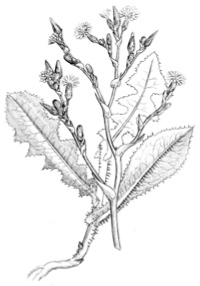
The wild cousin of all the cultivated varieties, wild lettuce has small, slightly prickly leaves and yellow flowers. It is much more bitter than cultivated lettuce. Native to Asia and Europe, it is naturalized in the United States.
USES Remember The Tale of Peter Rabbit? He ate too many of Mr. McGregor’s lettuces and fell asleep … Wild lettuce has a latex (a white waxy juice that oozes from the fresh stems), which contains an opiate. The latex forms an opiate-like sedative and pain-killer used to treat insomnia, hyperactivity, anxiety, and pain of various kinds.
Wild lettuce is taken in herbal medicine as a tea or tincture. In large doses it causes drowsiness.
LARREA TRIDENTATA
Creosote Bush
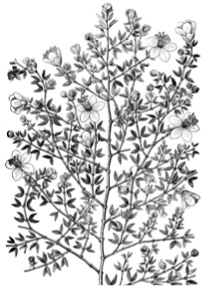
This fragrant evergreen shrub is a familiar sight in the deserts of the southwestern United States and northwestern Mexico. Growing to 3–9 feet in height, it has dark green leaves and yellow flowers.
USES Tea made from creosote leaves was traditionally used for detoxification, and to treat colds and pain from kidney stones.
Creosote bush is antifungal, antimicrobial, antiviral, and anti-inflammatory; it is also astringent and antioxidant. The plant makes a wonderful infused oil that heals wounds and soothes inflammations, bruises, and skin infections when applied to the skin.
It may be harmful to the liver taken in large doses over a long period, or in susceptible individuals, so do not take it internally unless done under the guidance of a qualified herbalist.
LAVANDULA ANGUSTIFOLIA AND SPP.
Lavender

This aromatic, purple-flowered perennial prefers dry, well drained soil and plenty of sun. It is grown commercially mainly for production of its essential oil, which is antiseptic and anti-inflammatory. Many related species have similar properties. It has been cultivated across Europe, Asia, and Africa for thousands of years.
USES Lavender is used in cooking cakes and desserts, and sometimes for flavoring cheese.
Medicinally, the herb is relaxing and antiseptic. It encourages liver function and is used to treat high blood pressure, exhaustion, anxiety, insomnia, headaches, and painful spasms.
The oil is used neat to heal burns and wounds, and is often used in household and personal care products. It is used also as a tea, tincture, and aromatic water. Do not take essential oils internally without professional supervision.
Motherwort

Originally from southern Europe and Asia, motherwort long ago spread across the world. This tall, strong perennial of the mint family has hairy, serrated, 3–5-lobed leaves, and lilac to pink flowers around the upper parts of the plant.
USES From the bitter taste, you can tell that motherwort stimulates the liver (as all bitter herbs do). Its names reflect its main medicinal uses—as an herb to strengthen the heart (“lionheart” in Latin) and to treat women’s conditions. Motherwort was particularly used to prevent women developing uterine infections after childbirth, and is still widely taken for menopausal difficulties, especially nervous problems. It is an excellent remedy for heart palpitations and weakness, hence its bold Latin name. It is commonly taken as a tea and tincture.
LOBELIA INFLATA
Lobelia
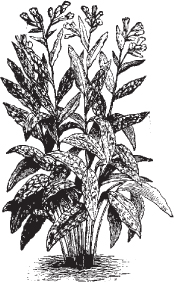
This hairy-stemmed plant has toothed leaves and small, pale purple flowers that are yellowish inside. It is native to the United States.
USES Lobelia contains strong alkaloids that relax the muscles; it is particularly good for asthma because it will open and relax the respiratory passages. It can be taken internally, and also applied externally, to relieve muscle spasms and cramps.
If you are giving up smoking, put a drop or two of the tincture directly on your tongue if you need help to reduce cravings.
Treat lobelia with respect because it is strong. It will make you sick in large amounts, so can be used as an emetic.
MATRICARIA CHAMOMILLA
Chamomile

Or German chamomile, a much-loved member of the daisy family with small yellow and white flowers and a distinctive fragrance. It is native to Europe and Asia. A close relative, Anthemis nobile or Roman chamomile, is similarly used.
USES Known as “the mother of the gut,” chamomile is a relaxing, antispasmodic sedative. It is used for all inflammations of the digestive tract, from top to bottom, and also helps insomnia.
Chamomile is a mild emmenegogue, meaning it can bring on delayed menstruation, and it has been used traditionally as a tea to treat vomiting in pregnancy. (Pregnant women should not use the essential oil.)
Used as a tea, tincture, infused oil, or essential oil, chamomile is also soothing for the skin. People allergic to ragwort are sometimes also sensitive to chamomile.
MELISSA OFFICINALIS
Lemon Balm

This sweetly lemon-scented hardy perennial is naturalized all over the United States. Similar to mint in appearance, but with bright green leaves and small whitish flowers, it has also been known as “heart’s delight.”
USES An effective sedative, lemon balm is good for insomnia, headaches, anxiety, stress, and hyperactivity. The flowering tops are taken to increase mental stamina, and as a digestive herb.
As well as bringing a fever down, lemon balm is antiviral internally and externally. It is good for cold sores and shingles, and the fresh juice applied to cuts and grazes helps them heal.
Lemon balm is an antihistamine and therefore good for allergies (including eczemas). It is safe for all to take.
Peppermint

Peppermint is an herbaceous perennial with square stems and opposite dark green pointy leaves, growing 12–35 inches. It is particularly easy to cultivate, spreading by underground roots to form new plants. Mints tend to prefer damp and shady habitats, and are easily recognizable by their distinctive smell and taste.
USES Rich in an essential oil, which gives it many of its properties, mint gives a sensation of cooling when applied to the skin. It stimulates the liver and digestion, so is useful for nausea and vomiting, indigestion, and heartburn (and often used to treat IBS).
Mint acts as a stimulant and gives a feeling of improved concentration. It lowers fever, improves appetite, and is a nutritious food. The herb is well used as a tea, oil, and tincture.
OCIMUM BASILICUM
Basil
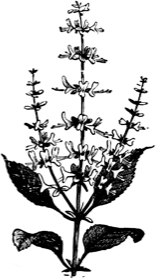
Basil is a strongly aromatic member of the mint family, with shiny green leaves and very small white flowers. Native to India, it has been cultivated in southern Europe and across Asia for thousands of years. It is easy to grow on a sunny windowsill.
USES Basil is a delicious and versatile culinary herb. An antiviral and antimicrobial plant, it is a superb strengthening tonic for the whole body. It helps the digestion and increases milk flow in nursing mothers. Basil makes a relaxing tonic for the nerves and is good for respiratory ailments.
Its cousin, O. sanctum, or holy basil, is considered in Ayurvedic medicine to be a supreme healing tonic. It is sacred to Vaisnavas, being Krishna’s most beloved plant.
ORIGANUM VULGARE
Oregano
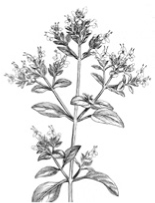
Oregano and its close cousin, O. marjorana (marjoram), are native to the Mediterranean and Asia. Both are small-leaved, highly aromatic members of the mint family, with tiny, pink-purple flowers. They prefer the heat and a well-drained soil, but can be surprisingly hardy when grown.
USES Oregano and marjoram are well-known culinary herbs that lend a distinctive “Italian” flavor to dishes. Both are healthful, nutritious, and tasty additions to the diet. They are used in traditional medicine for their antiseptic properties, especially in treating stomach and respiratory infections. They are aromatic bitters, helping the digestion.
PANAX GINSENG & P. QUINQUEFOLIUS
Chinese Ginseng & American Ginseng

Panax ginseng, a perennial plant in the ivy family, has small red berries and a fleshy root. It is found mainly in Korea and China. American ginseng is similar but native to North America; it is also cultivated in China. They are both particularly prized as medicines.
USES Ginseng is an “adaptogen,” meaning that it protects the body and mind from the damaging effects of stress. It is beneficial to the immune system and can help with recovery from cancer, especially with problems arising from radiation therapy and chemotherapy. It is traditionally used as an aphrodisiac. Too much can lead to agitation (as with too much caffeine).
Passionflower

Also known as maypop, this vine has curly tendrils that hang on as it climbs. It produces gorgeous purple flowers, many varieties of which are cultivated for flowers and fruit. It is native to the United States.
USES The leaves and flowers have long been used as a general relaxing and calming sedative for insomnia and anxiety, epilepsy, and high blood pressure. They are a remedy for twitchy limbs, hyperactivity, pain (in particular nerve pain), and to help manage withdrawal from addictions to alcohol and other drugs.
Do not take high doses in pregnancy. Passionflower can also cause drowsiness.
PHYTOLACCA DECANDRA
Poke Root
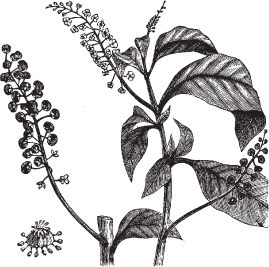
A U.S. native with red stems, narrow green leaves, small, greenish white flowers in spikes, and black berries, pokeroot grows up to 10 feet tall. In large doses it is poisonous, but it is a useful medicine in small amounts.
USES Poke root helps the lymphatic system and kills parasites in the digestive tract. It is used for sore and swollen glands, for breast disease, and to assist the body to rid itself of cancer.
The herb is anti-inflammatory when applied externally. A tincture made from the fresh root is used in small amounts, usually not more than 2 tsp. per week (3–4 drops per dose).
Large doses cause vomiting. Do not use in pregnancy.
PLANTAGO SPP.
Ribwort, Plantain

Both herbs are herbaceous perennials. Ribwort (Plantago lanceolata), which is also known as narrowleaf plaintain, is named for the characteristic veins running straight up the narrow leaves, stem to tip. Plantago major, or plantain, is similar, but with round leaves instead of long. The flowers of both are brownish bobbles at the end of long, square stems. They are native to Europe and Asia, and naturalized in the United States.
USES Plantain/ribwort are so nutritious that the whole body feels their benefit when they are eaten. As a medicine, they tone and dry the mucous membranes of the body, thus helping the lungs, digestive tract, kidney, bladder, and reproductive organs. They help to calm allergies and support the lymphatic system; they are also outstanding wound healers.
POLYGONATUM BIFLORUM
Smooth Solomon’s Seal

Native to the United States and China, Solomon’s seal is cultivated as a garden plant in Europe for its elegant arched stems, from which hang many small white flowers.
USES The young shoots and leaves can be boiled like asparagus, and the rhizomes ground to make flour for baking.
The root is taken and applied externally for arthritis and any musculoskeletal problem, including injuries. Additionally it is a soothing demulcent (meaning it has a softening action) for the lungs and digestion and an adrenal tonic that supports the heart, liver, and kidneys. Solomon’s seal is a mild sedative and sometimes helps diabetes and high blood pressure.
The aerial parts, especially the berries, are poisonous.
Rose

There are more than a hundred species of roses found all over the world. The ones advisable to use for medicine or food include R. canina, R. arkansa, R. laevigata, and R. rugosa.
USES The flowers are edible, as are the fruits; known as “hips,” they are exceptionally rich in vitamin C. The seeds contain an oil, which is extracted as an antioxidant and scar-reducing agent. Rose is also known to reduce the effects of aging when applied to the skin.
Taken internally, rose is an uplifting herb. Helpful to the stomach and digestion, it is also a liver stimulant and tonic for the womb and kidneys. Some species have anticancer activity.
Use the listed wild species for food and medicine, not garden hybrids.
ROSMARINUS OFFICINALIS
Rosemary

This aromatic, perennial, woody-stemmed shrub is native to the Mediterranean and needs plenty of sunlight to flourish fully. Its green-white, needlelike leaves and purple, pink, white, or blue flowers smell strongly of the essential oil in which rosemary is rich.
USES Both the fresh and dried herb and the essential oil are often used in medicines, foods, and household products as a good antibacterial.
Rosemary promotes the circulation, especially the blood flow to the brain. It is used to treat headaches, depression, and weakness, to stimulate the liver and digestion, and to strengthen the heart.
Make a tea or tincture of the flowering tops for internal use. Do not take the essential oil internally without some professional supervision.
RUBUS IDAEUS
Raspberry

This red-fruited plant with a light green prickly stem and leaves that are green on top and white underneath is native to Europe and Asia, but now widely grown. Its close cousins have similar actions. For example, the U.S. black raspberry is a super antioxidant, which seems to have anticancer benefits.
USES The fruit is a delicious and healthy food, rich in antioxidants. Leaves can be taken as a womb tonic for threatened miscarriage, to prepare for pregnancy, or as part of infertility treatment. It is also taken as a tea for the last 2–4 months of pregnancy to prepare for childbirth, and taken after birth to nourish the uterus and increase milk production.
Raspberry’s astringency makes it useful to treat diarrhea, and as a wash for canker sores and tonsillitis.
SALIX ALBA AND SPP.
White Willow

These beautiful trees love damp places, especially riverbanks. They have flexible wood and green-white leaves, and bees love their small, pollen-rich flowers. The anti-inflammatory medicine salicylic acid (aspirin) was first isolated from white willow bark in 1838. Willows grow in most temperate zones of the world.
USES Willow is also used to fuel ecologically effective and sustainable heating systems, as it grows very fast and takes more CO2 from the air when it grows than it releases when it is burned. It is a good charcoal-making plant. You can also steam the young leaves and eat them.
Willow bark is an antiseptic anti-inflammatory and a mild pain-killer that reduces fevers. It is used for arthritis, headaches, and stomach inflammation. Avoid if you are allergic to aspirin.
Elder
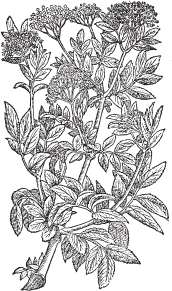
Sambucus nigra in Europe and S. canadensis in the United States is a small tree or large shrub. Common in Europe and North America, it produces creamy white clusters of small flowers, which develop into small, juicy, purple-black berries.
USES The flowers and leaves increase sweating, are diuretic, and anti-inflammatory. They are used in teas, tinctures, and lotions for coughs and colds, and to treat arthritis and rheumatism.
The berries are rich in vitamin C and are a powerful antiviral agent. They have a normalizing effect on the bowel and so can be used to help diarrhea, although they are also a mild laxative.
SCUTELLARIA BAICALENSIS
Baical Skullcap—Huang Qin
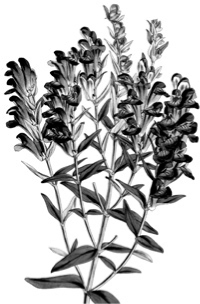
An herbaceous perennial from China with purple-blue flowers and lance-shape leaves, baical skullcap grows to 1–4 feet in height. In China, it is cultivated both as an ornamental plant and an important medicine. It is now also widely grown in the United States.
USES The yellow root is one of Chinese medicine’s fundamental herbs, used “to clear heat” from the body. An exceptional blood cleanser, it is useful for detoxing and for fighting infections—especially fevers of the lungs, throat, nose, and sinuses, when the mucus is thick and yellow.
Baical skullcap stops bleeding and aids the healing of wounds. A liver tonic, it can be used in place of golden seal, which is endangered.
Do not use in pregnancy except under some form of professional supervision.
SCUTELLARIA LATERIFLORA
Skullcap

A perennial member of the mint family, this herb loves wet habitats. It has nettlelike leaves with serrated edges and blue-pink flowers. It is native to the United States and is cultivated in Europe.
USES Skullcap is good for the nerves, and is widely used all over the world for almost any problem of the nervous system. It reduces anxiety, helps relaxation, and aids recovery from debility caused by long periods of overactivity and overwork. Related species are similarly used.
SALVIA OFFICINALIS AND SPP.
Common Sage

An aromatic flowering herb in the mint family, common sage has gray-green leaves and lilac flowers. It is a Mediterranean native, but is now widely naturalized.
USES Sage is a culinary herb, delicious in savory dishes and salads.
It is used all over the world as a medicine for infections, lung and digestive disorders, and skin problems. It is also an excellent general tonic for weakness and debility following illness.
Sage is a nourishing tonic for the brain and can relieve excessive sweating, including that occurring during menopause. Externally it helps to speed the healing of bruises and inflammations.
Do not take medicinal doses if pregnant (but as a spice in food it is fine), or if epileptic.
Milk Thistle

This robust, pink-purple-flowered thistle is native to Europe. It has prickly, variegated green and white leaves and can grow up to 5 feet tall. Milk thistle is widely cultivated, and its seeds have been used in healing for more than 2,000 years.
USES Milk thistle seeds are a powerful healing agent for the liver, both protecting it from toxins and encouraging its regeneration. The herb is used to treat serious liver problems, including hepatitis and liver damage from drug and alcohol use. Milk thistle can be taken to protect the liver from the toxicity of medicines, including those used in medical treatment, but this can make medications less effective, because it speeds up their removal from the body. The ground seeds are commonly taken as capsules or tea.
SOLIDAGO SPP.
Goldenrod

Native to the United States and introduced in Europe, goldenrod is an herbaceous perennial with a lovely spike of pollen-heavy yellow flowers.
USES Goldenrod flowers, seeds, and leaves can be added to soups, stews, and stir-fries.
It is a good tonic herb for the kidneys, even being used to treat serious problems, such as nephritis, and also supports the bladder and prostate.
Goldenrod is an anticatarrhal and anti-inflammatory tonic to the mucous membranes, used to treat the digestive system and chronic mucus in the nose, throat, and ears. It is taken as a tincture or tea.
STACHYS OFFICINALIS
Wood Betony
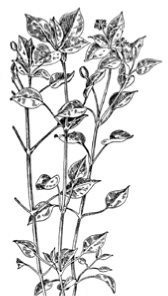
Also known as Stachys betonica, this perennial herb is native to grasslands in Europe, North Africa, and Asia. It has smallish, toothed leaves and clusters of purple flowers, on spikes that grow to 1–2 feet tall. It is cultivated in North America, where it is also known as hedgenettle, and sometimes is found naturalized.
USES Wood betony is a powerful remedy for the stomach and the nervous system. It is a bitter tonic, especially beneficial for the brain. A tea or tincture is used to treat dizziness and dementia, as well as a sluggish liver, gallbladder problems, and poor digestion.
Do not take during pregnancy.
STELLARIA MEDIA
Chickweed

This creeping annual grows in the colder seasons in many locations in Europe and North America. Its Latin name comes from its tiny, star-shape white flowers, which peep out from its bright green leaves, shaped like mice’s ears.
USES Chickweed is tasty and nutritious, good to eat raw or lightly cooked; it is also great food for chickens. In herbal medicine, it is used for skin diseases and arthritis, and for bronchitis and lung disease. The plant is taken internally as a tea or tincture and externally as a cream, ointment, or infused oil.
Comfrey
Comfrey thrives in damp and cool conditions. It has fleshy, dark green, hairy leaves and blue-purple, or sometimes white-pink, flowers. Its black roots conceal a white, gloopy (mucilaginous) interior.
USES Also known as knitbone, comfrey considerably speeds the healing of connective tissue (ligaments, tendons, bones, and skin). It is used inside and out as tea and tincture, but the root is not taken internally because it contains pyrrolizidine alkaloids, toxic to the liver in large amounts.
People with liver problems and those taking medications should avoid comfrey. Otherwise the leaves are fine for short-term use.
Do not use on open wounds because comfrey makes the skin heal so quickly it can heal over dirt or infection, tending to form raised scars.
TARAXACUM OFFICINALE
Dandelion

A common, yellow-flowered weed that grows every year from its deep root. Leaves are long and toothed, growing from a main flower stalk. The cluster of flowers later forms a seed head of hundreds of tiny seeds with fluffy hairs attached, enabling it to travel to new locations on the wind. It is native to Europe, Asia, and the Americas.
USES The roots and leaves of dandelion are nutritious and used as foods and medicines everywhere the herb grows. Medicinally, the leaves are a powerful diuretic and kidney and liver tonic. The root is a strong liver tonic and stimulant, and a gentle laxative.
Dandelion is used to detoxify and cleanse the body in treating skin and joint problems, cancers, headaches, and general weakness.
THUJA OCCIDENTALIS
White Cedar

An evergreen in the cypress family bearing small cones, white cedar is native to eastern North America and grown in Europe as an ornamental plant. The branches, stem, and tiny, flat, scalelike leaves contain a strong essential oil.
USES The plant is traditionally used to treat menstrual problems, headaches, and heart ailments.
It is a diuretic used to relieve rheumatism and also helps catarrhal chest complaints. The herb is also used to reduce growths, including warts.
Liquid extracts, tinctures, and tea made from white cedar are taken internally in small doses (the tincture generally used at 1 tsp./5ml a week). The essential oil is used externally.
Do not take when pregnant or breastfeeding.
THYMUS SPP.
Thyme
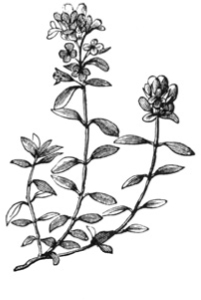
There are many species of this small-leaved, aromatic herb with woody stems and tiny pink flowers. Thymus serpyllum, or wild thyme, is native to southern Europe and a cultivated variety of this, T. vulgaris, is grown all around the world.
USES Thyme contains an essential oil high in “thymol,” a potent antiseptic. It is used against infections, particularly of the lungs and the digestive tract, including worms. Because it is relaxing for spasm, thyme is helpful for asthma and tight, aching muscles. It is a good general tonic.
Do not use the essential oil when pregnant, and never take internally in any but the minutest amounts (and not even these if you have liver or kidney problems).
Red Clover
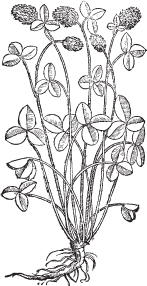
A beautiful, low-growing meadow flower with pink, globe-shape flower heads made of many tiny flowers. White markings decorate the 3-lobed leaves (occasionally you may find a 4-leaved clover, said to be lucky). It is native to Europe, Asia, and Africa and is naturalized in North America.
USES This is a nourishing flower to eat any time, including during pregnancy. Red clover was traditionally used for coughs and respiratory problems, and also in treating cancer; it helps to stimulate the immune system into healthy functioning. The herb also has a mildly blood-thinning effect and is helpful for menopausal problems, such as hot flashes.
Do not take red clover if you are on warfarin or other blood thinners.
TUSSILAGO FARFARA
Coltsfoot

Coltsfoot is native to Europe, and can now be found in Canada and America’s northeastern states. Its yellow dandelion-like flowers emerge in late winter to early spring. They then die down, and a month or so later the heart-shape gray-green leaves appear.
USES Both the leaves and flowers of coltsfoot are an excellent expectorant and strengthening lung tonic.
Like comfrey, it contains pyrrolizidine alkaloids, which in large amounts are toxic to the liver; therefore, coltsfoot is not recommended for long periods of use, nor for people with liver problems or those taking medications (because most of these are toxic to the liver).
Do not take while pregnant or breastfeeding.
UMBILICUS RUPESTRIS
Navelwort or Wall Pennywort
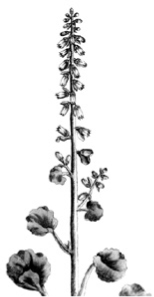
Native to Europe, navelwort grows on walls in shady places. It is a fleshy succulent with round leaves. The stem in the middle, which can be found all year round, is more prolific in the summer months when the flower spikes grow.
USES It is delicious to eat and can be gathered in all seasons. Navelwort juice is cooling and eases pains, both taken internally and applied externally.
Apply the juice or fresh poultice, or an ointment, to painful ears, painful hemorrhoids, wounds, gout, nerve pains, and sore throats. Take navelwort as a juice or tea for pains in the kidneys and digestive system.
URTICA DIOICA
Stinging Nettle

This perennial plant can grow more than 3 feet tall from its network of thin whitish roots, and has green, sharply serrated leaves. The undersides of the leaves are covered in fine, histamine-containing hairs which sting you if touched. It is native to Europe, United States, Asia, and North Africa.
USES Nettles are one of the great panaceas of the plant world. Rich in minerals and vitamins and amino acids, in some countries they are one of the best, and easiest to find, wild plants to use as a food. The new green tops and the seeds are edible. Nettle leaves are used for arthritis, skin problems, and allergies, and are generally detoxifying and cleansing. Nettle root helps the prostate gland.
Bilberry or Huckleberry

Bilberry is a low-growing, shrubby member of the heather family that grows on heaths, moors, and mountainous areas of Europe, Asia, and North America. It has small leaves and produces deep red-black fruits (resembling small blueberries).
USES Bilberries are edible. The leaves and berries gathered before the berries ripen are used to protect eyesight and help with macular degeneration, cataracts, and diabetic eye problems. Bilberries can also help with high blood sugar, so are ideal for diabetics.
Like other deep red-black fruits, the plant nourishes and helps to repair arteries and veins. Fresh berries are laxative, but dried ones are anti-infective and binding, so good for diarrhea. Leaves are also used to treat cystitis, kidney, and bladder complaints.
VALERIANA OFFICINALIS
Valerian

Every spring, this perennial begins to grow from a bundle of rhizome and thin roots to a tall, leafy plant, with flower heads of many small, pale, white and pinkish flowers. It prefers damp soil. It is native to Europe and northern Asia, but is much used in herbal medicine in the United States.
USES The part of valerian used in medicine is the root and rhizome, and they have an extraordinary smell—you either love or hate it. Valerian is one of the most researched herbal sedatives and is used for anxiety, stress, insomnia, and physical tension. It is taken as a tea, pills, and tincture. Cats (including lions) adore it.
Valerian can cause drowsiness and may react with sedative medication.
VERBASCUM THAPSUS
Mullein

Native to Europe but naturalized in the United States, this beautiful herb has a tall spike of yellow flowers at its top and pale green-gray leaves. They feel as soft as velvet, being densely covered with fine hairs.
USES Mullein is so rich in vitamins and minerals that it is a good herb to drink as tea regularly—although not very nice to eat because of its furriness.
Mullein leaves and flowers soothe and calm inflamed lungs, helping deep and painful coughing, and ease the expectoration of mucus. They are also useful in treating hay fever and bed-wetting. Externally mullein is a good wound healer and helps to reduce piles. An oil made from the flowers is specific for earache.
It is used in smoking mixtures.
VERBENA SPP.
Vervain
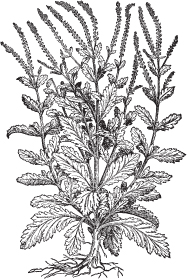
Vervain flowers form spikes of small, blue-purple blossoms. The European plant V. officinalis is spindly with purplish flowers, and its U.S. cousin, V. hastate, has sturdier stems and blue flowers. Both plants are used in similar ways.
USES Vervain is a key herb for treating the nervous system. Herbalists value the plant as a relaxing nervine used for stress, tension, and nervous exhaustion. It is also a stimulating bitter tonic for the liver.
Vervain was one of the most important plants of the Druids, being considered a powerful magical plant.
Do not use during pregnancy.
Cramp Bark

This deciduous shrub—also known as cranberry bush—is almost a tree, has vinelike leaves, white flowers, and red berries. It is native to the United States and Europe.
An American cousin, Viburnum prunifolium (black haw), is also used in herbal medicine.
USES As the name cramp bark suggests, this plant is a muscle relaxant and antispasmodic. Cramp bark is used to treat muscle cramps and tension, period pains and threatened abortion (it relaxes the womb), asthma (it relaxes spasm in the bronchial tubes of the lungs), colic, and spastic pains in the digestive tract. The herb also improves the circulation by opening blood vessels. Its American relative, black haw, is used similarly; it also treats morning sickness and problems in menopause.
VIOLA SPP.
Sweet Violet & Heartsease (Johnny-Jump-Up)

These two members of the violet family (Viola odorata and V. tricolor) are native to Europe and naturalized in the United States. Sweet violets have a delicious smell and are the traditional violet color. Heartsease is a “tricolor” pansy, with white, purple, and yellow flowers.
USES Both herbs are used to treat bronchitis, asthma, and other lung problems. They are also useful for cystitis and an irritated bladder.
Sweet violet helps to relieve congested lymph flow. It has also been used, internally and externally, in treating cancers and growths, both as a curative and a pain reliever.
Heartsease is particularly used for wet eczema and other skin diseases with sticky discharges.
VITEX AGNUS-CASTUS
Chasteberry

The tiny, yellow-red berries of this beautiful, aromatic Mediterranean flowering tree are known as “monkspepper” for its “an-aphrodisiac” effect—hence its other name of lilac chastetree.
USES Chasteberry is used to treat premenstrual syndrome and menstrual irregularities, including those associated with menopause and polycystic ovarian syndrome. The plant can also help some women to conceive if infertility is caused by low progesterone levels, and it increases production of breast milk. Chasteberry can also be useful for acne and headaches associated with hormone imbalance, and can calm acne in teenage boys.
ZINGIBER OFFICINALE
Ginger
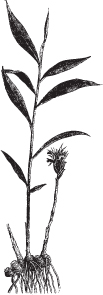
Ginger is widely known as a pungent culinary spice. The root of this relative of turmeric and cardamom originated in Asia, but is now used all over the world. It is a perennial plant resembling a reed, with lovely yellow flowers.
USES Used in cooking savory and sweet dishes, as well as in pickles and confectioneries, ginger stimulates the whole system. The herb makes you sweat and so reduces fever, clears mucus from the head, sinuses, and lungs, and relaxes and stimulates the digestion, thus helping to treat indigestion, gas, and colic. Ginger helps to reduce nausea of all kinds, and is safe to take for morning sickness in pregnancy.
It is also an excellent circulatory stimulant and can help to reduce high blood pressure.